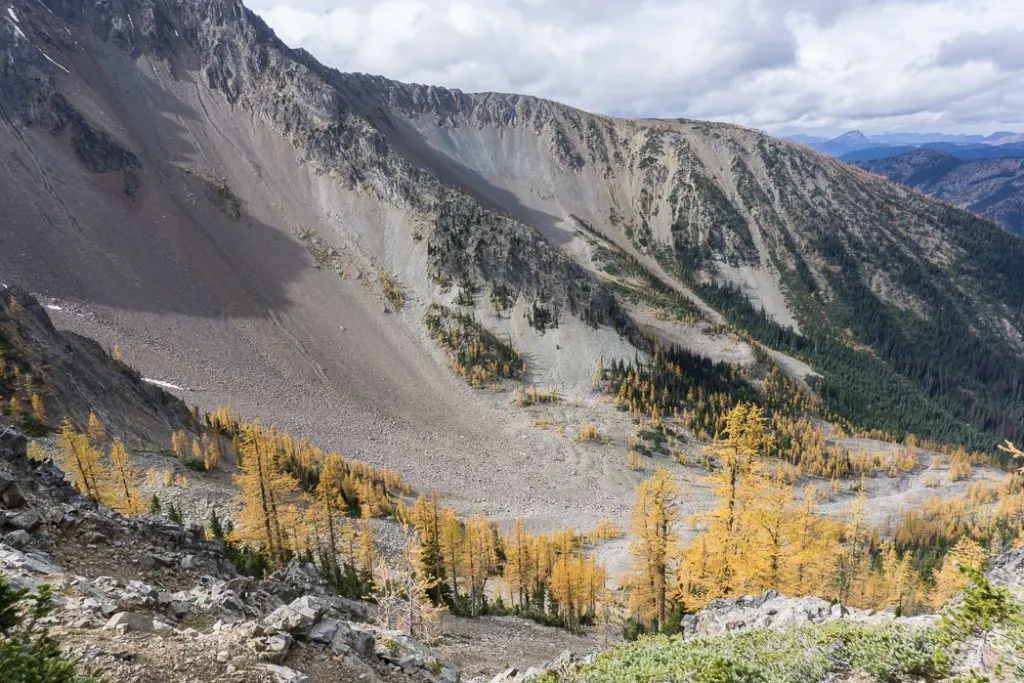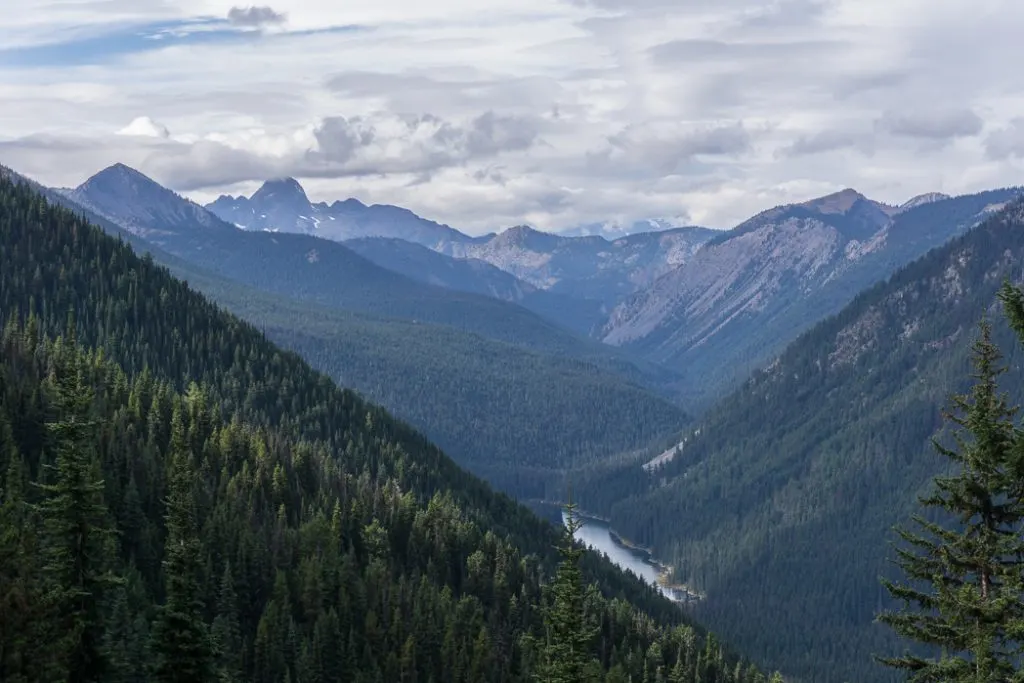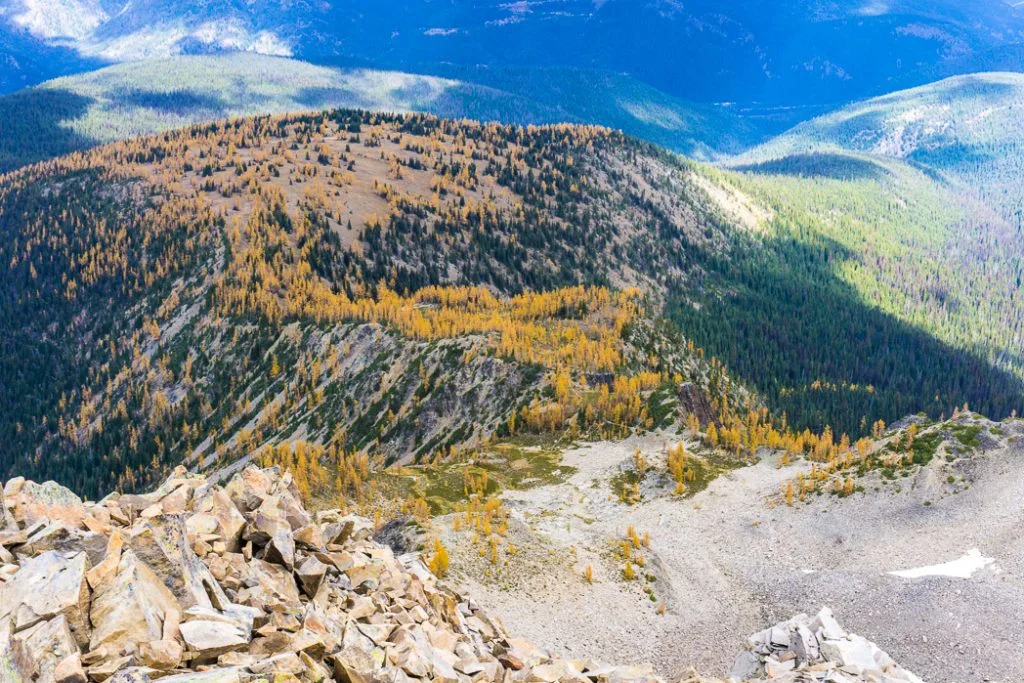If you think of fall hiking, you are probably picturing strolling through a beautiful maple forest with red and gold leaves everywhere. That kind of scene is quintessentially autumn, but it’s kind of an East Coast cliche. We don’t have much of that near Vancouver.
What we do have, however, is a pretty unique fall sight: the Frosty Mountain larches in Manning Park. These rare coniferous trees look like a regular pine tree until fall. And then… BOOM! They turn a gorgeous gold colour. Want to find out how you can hike to them? Read on!
This guide to hiking to Frosty Mountain in larch season includes:
- What are larch trees?
- What time of year do the larches change colour?
- What to pack
- Hike overview with stats including info for getting to the larches and to the summit
- Driving directions
- Hiking directions
This is a sensitive wilderness area. Learn how to Leave No Trace to keep the wilderness wild. Make sure you are prepared by bringing the 10 Essentials. Get ready for adventure with this checklist of things to do before every hike.
Hey there: Some of the links in this post are affiliate links, which means I earn a small commission at no cost to you. Thanks for your support. -Taryn
What are larch trees? Why are they special?
The golden larches that grow near Frosty Mountain in Manning Provincial Park are more formally known as alpine larches. (Or larix lyallii if you’re into fancy latin names.) They are a VERY unique tree. Alpine larches are coniferous trees, just like a pine tree or a Christmas tree.
But, they are NOT evergreen: they actually change colour and shed their needles each fall the way a maple tree does. (Well a maple tree does it with leaves, not needles. But you get the picture.)
Alpine larches are also pretty bad ass. They live at high elevations with rocky soil and cold temperatures. The ones on Frosty Mountain live at about 2000m above sea level. The larches can live incredibly long – over 1000 years – which is surprising since they aren’t particularly large trees.
Alpine larches grow mostly in the Rocky Mountains and in the eastern parts of BC and Washington since they need a dry and cold climate. But Manning Park has a teeny tiny pocket of prime larch habitat. It’s high enough, dry enough, cold enough and rocky enough to support larch trees. And it’s waaaay up on the side of Frosty Mountain, so you have to hike up there to see them.

What time of year can you visit the Frosty Mountain larches?
The hike to Mount Frosty and the larch plateau is snow free from about mid June until early October. However, the best time to go is late September or early October when the larches change colour. If you go too late, the larches will already have dropped their needles and they’ll be all naked and sad. If you go too early they will still be green.
The trail is busy on weekends in prime larch season. Try to plan your trip for a weekday if possible.
You do not need a day pass, but if you want to camp at the backcountry campground, you need a reservation to camp between late July and late October (dates vary each year). You can make a reservation on the BC Parks website up to four months before your trip. See my guide to making backcountry camping reservation for tips.
What to pack to hike to the larches?
If you visit in fall, be prepared with cold weather gear. (Read my tips about what to wear for hiking in the winter). It can below zero at the larch plateau and on the summit of Frosty Mountain, even if it is sunny and warm in the parking lot.
City forecasts are useless in the mountains. Use an algorithmic weather forecast for Frosty Mountain using a app like Spotwx or Mountain Forecast. (Both are on my list of the best weather apps for hikers.)
You can’t see it in any of my pictures, but it did snow slightly the day I took these, and the wind was bitterly cold. I was glad for my warm jacket, hat and gloves.
It’s pretty common for it to snow when the larches are changing. The trail can be slippery and icy so it’s a good idea to bring microspikes.
I like the Kahtoola Microspikes. They are pointy enough to grip most moderate ice and the rubber straps stretch to fit both my trail runners and my bigger backpacking boots.
(Curious about what microspikes are? My guide to microspikes vs. crampons explains it all.)

Frosty Mountain Larches Hike Overview
Distance: 18km round trip to the larch plateau, 22km round trip if you go all the way to the peak of Mount Frosty)
Elevation gain: 800m to the larch plateau, 1150m to the peak of Mount Frosty
Time Needed: 7 hours round trip to the larch plateau, 9 hours round trip to the peak of Mount Frosty (You can also make it into an overnight trip by camping at the Frosty Creek campsite. See the description below for more info.)
Dogs: Permitted but dogs must be on a leash. The last time I hiked this trail on a busy fall day we ran into 2 different people who had lost their dog!
Note: This trip is also possible as a loop that will add a bit more time and distance to your trip. The trip described here is an out and back to the summit of Frosty Mountain via the larch meadow. For more info on the loop option, see the hiking section of the E.C. Manning Provincial Park website.

Frosty Mountain Larches Driving Directions
From Vancouver take highway 1 and highway 3 to the Manning Park Lodge. Turn right off the highway onto Gibson Pass Road. Follow Gibson Pass Road for about 3km to a fork. Take the left (lower) fork. Arrive at the Lightning Lake day use parking lot a few hundred meters after the fork.
Here are Google Maps driving directions.
Frosty Mountain Larches Hiking Directions
Starting the Hike
From the Lighting Lakes Parking lot head to the left/east side of the lake. Walk across a bridge and across an earthen dam.

At the other side of the lake, take the trail going uphill, marked Frosty Mountain. The trail ascends the slope in a long series of switchbacks for about 5km. The climb is steady but never exceptionally steep.
After the first few kilometers you’ll start to get some small peek-a-boo views through the trees of Lightning Lake and the surrounding mountains.

After the switchback section the trail levels off for a few kilometers and rambles through the forest. At about the 7km mark you will reach the Frosty Creek campsite.
This campsite has an outhouse, nine tent sites and a bear cache to store your food. It also has a rough dirt-floored emergency shelter. There is a small creek at the campground, but it may be totally dried up in the fall. You must make a reservation to camp here between late July and late October each year.
To the Larch Plateau
After passing the campsite, the trail climbs steeply for another kilometer or so. It is around this point that you will begin to see the first larch trees.
You’ll know you’ve arrived at the larch plateau when you spot an interpretive plaque about the larch trees. (There will also be big larch trees everywhere!). The trail rambles through the larches along the flattish plateau for about a kilometer before starting to climb again. If you don’t plan to climb Frosty Mountain, turn around here.



To the Summit
The trail gets rockier and starts to climb above the treeline at about the 9.5km mark. You’ll have to follow a worn path up a scree slope to attain a ridge. The rocks here can be a bit loose and slippery so if you are afraid of heights, you may want to skip a trip to the summit.

Once you get to the top of the ridge, you’ll see the sign that marks the junction with a trail that descends to the east to the Pacific Crest Trail. Stay on the ridge and follow it south towards the summit of Frosty Mountain. You have only half a kilometer to walk but it is slow going: the ridge is narrow and the trail is rocky.

Once you reach the summit you will be at an elevation of 2408m! You are on the east summit of Frosty Mountain. The true summit of Frosty Mountain is just to the west of you and about 20m higher. Either way, you are on the highest peak in Manning Provincial Park. The mountains to the south of you are in the USA, just 1 kilometer away. Make sure you take a look back down to the larch plateau.



After you’ve enjoyed the views on Frosty’s rocky summit, retrace your steps to your car. Make sure to leave time for more photos at the larch plateau on the way down.

Final Thoughts
I first heard about Frosty Mountain larches years ago, but I didn’t really know what to expect until I visited them myself. I couldn’t believe these hardy little trees could grow in such an inhospitable environment. And that they could grow so old!
The golden colours of the larch needles against the blue sky are so stunning. It’s simply something you have to experience for yourself. Have you hiked to the Frosty Mountain larches or to golden larches in other areas? Tell me about it in the comments.
READ NEXT:
- The Best Vancouver Hiking Books
- Most Instagrammed Hikes in Vancouver in 2021
- How to Hike the Big Cedar and Kennedy Falls Trail in Vancouver
- Alternatives to the Grouse Grind: Steep Workout Hikes Near Vancouver
- 35+ Vancouver Hikes You Can Get to on Transit
- Lake O’Hara Packing Lists for Hikers and Campers - April 25, 2025
- BC Parks Day Passes 2025 – Everything You Need to Know - April 24, 2025
- Best Women’s Hiking Pants (Picks for Every Body Type) - April 21, 2025


Kathie
Thursday 28th of September 2017
Spider Gap in the Central Cascades also has great Larches. As do the Enchantments out of Leavenworth.
Sarah Taylor
Friday 22nd of September 2017
Hey was this from this year already? Or is this from another year. Curious if the Larches have turned. Great to hear about the bear cache. I couldn't remember if there was one, and it doesn't say on their website. Cheers. :)
Taryn Eyton
Tuesday 26th of September 2017
Hi Sarah, These photos are from October 1, 2016. I have seen on Facebook and Instagram that the larches have just started to turn this year and that there is some snow on the ground. Happy hiking!